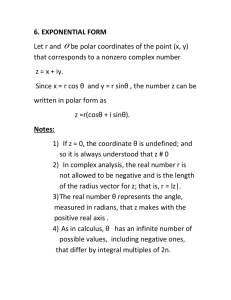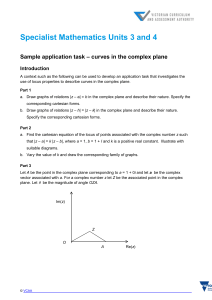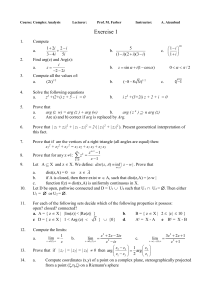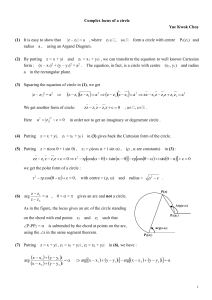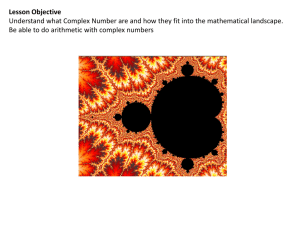complex_004
advertisement
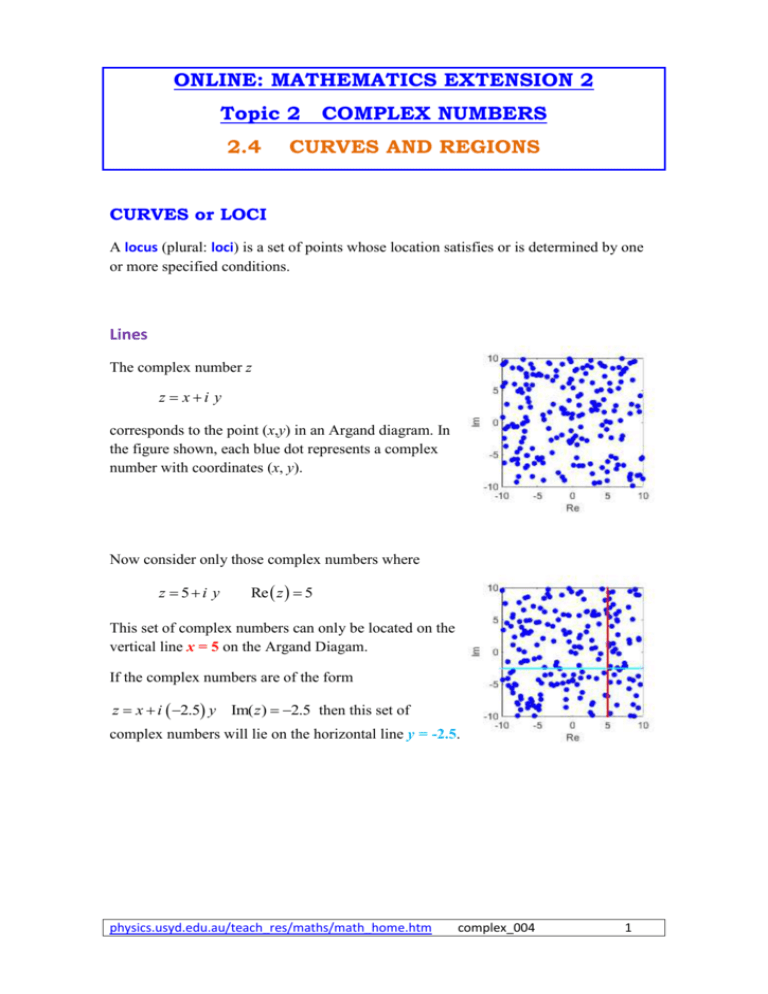
ONLINE: MATHEMATICS EXTENSION 2 Topic 2 2.4 COMPLEX NUMBERS CURVES AND REGIONS CURVES or LOCI A locus (plural: loci) is a set of points whose location satisfies or is determined by one or more specified conditions. Lines The complex number z z xi y corresponds to the point (x,y) in an Argand diagram. In the figure shown, each blue dot represents a complex number with coordinates (x, y). Now consider only those complex numbers where z 5i y Re z 5 This set of complex numbers can only be located on the vertical line x = 5 on the Argand Diagam. If the complex numbers are of the form z x i 2.5 y Im( z) 2.5 then this set of complex numbers will lie on the horizontal line y = -2.5. physics.usyd.edu.au/teach_res/maths/math_home.htm complex_004 1 Let z1 and z2 be two points on an Argand diagram. Consider an equation of the form z z1 z z2 The distance between the points z and z1 is d1 z z1 and the distance between the points z and z2 is d2 z z2 . So for any z value we must have d1 d 2 . Therefore z must correspond to a straight line passing through the centre of the line joining the two points z1 and z2 and perpendicular to it. z z1 z z2 equation of the perpendicular bisector of the line joining z1 and z2. Circles z xi y The equation of a circle of radius R with centre (0, 0) is z R z x2 y 2 R x 2 y 2 R2 The equation of a circle of radius R with centre given by z1 (x1, y1) is z z1 R z x x1 x x1 2 2 y1 R 2 y y1 R 2 2 physics.usyd.edu.au/teach_res/maths/math_home.htm complex_004 2 Arguments z xi y arg z a tan y x z1 x1 i y1 The equation arg( z ) corresponds to the line draw from the origin (0, 0) to any complex numbers z such that the angle of the line with respect to the real axis is . The equation arg( z z1 ) corresponds to the line draw from the point (x1, y1) to any complex numbers z such that the angle of the line with respect to the real axis is . Locus of an arc The locus of a point z on an Argand diagram that satisfies the relationship z z1 Arg Arg z z1 Arg z z1 z z 2 is the arc of a circle. Let 1 Arg z z1 2 Arg z z2 then 1 2 1 Arg z z1 is the locus of a straight line (1) starting at z1 and making an angle 1 with the real axis. 2 Arg z z2 is the locus of a straight line (2) starting at z1 and making an angle 2 with the real axis. z z1 Arg Arg z z1 Arg z z1 is the locus of the point z which is the z z2 point of intersection of the two straight lines (1) and (2). As the angle 1 increases and 2 decreases with remaining constant the intersection point z moves along the arc of a circle in an anticlockwise direction (starting at z1 the arc is in anticlockwise sense to z2 z z1 z z2 ). The points z1 and z2 and all the points z lie on the circle. If is acute ( < 90o) then the points z are on the major arc and if is obtuse ( > 90o) z is on the minor arc. physics.usyd.edu.au/teach_res/maths/math_home.htm complex_004 3 Plot of z as 1 increases z4 Arg z 3i Arg z 4 Arg z 3 i / 4 z1 4 z2 3 i / 4 1 82o to 212o steps of 5o z moves anticlockwise around the major arc as 1 increases z z1 z z2 physics.usyd.edu.au/teach_res/maths/math_home.htm complex_004 4 Plot of z as 1 increases z3 Arg z 2i Arg z 3 Arg z 2 i / 4 z1 3 z2 2 i / 4 1 17o to 142 o steps of 5o z moves anticlockwise around the major arc as 1 increases z z1 z z2 Plot of z as 1 increases z4 Arg z 3i Arg z 4 Arg z 3 i / 4 z1 4 z2 3 i / 4 1 86o to 212o steps of 5o z moves anticlockwise around the major arc as 1 increases z z1 z z2 Plot of z as 1 increases z 5i Arg z4 Arg z 5 i Arg z 4 3 / 4 z2 4 3 / 4 z1 5 i 1 86 to 126o steps of 5o o z moves anticlockwise around the minor arc as 1 increases z z1 z z2 From the coordinates of the three points z, z1 and z2 on the circle you can find the centre of the circle and its radius (view). physics.usyd.edu.au/teach_res/maths/math_home.htm complex_004 5 REGIONS The complex number z z xi y corresponds to the point (x,y) in an Argand diagram. The figure shows the location of 400 random complex numbers in the complex plane. When restrictions are placed upon the values of z, then the plotted values of z that satisfy the restriction will give well defined allowed regions (or lines) in the complex plane. Re z x 2 and Im( z ) y 5 z x2 y 2 5 The allowed region is all points within the circle of radius 5 and centre (0, 0) but it does not include points on the circumference. z x2 y 2 5 The allowed region is all points outside the circle of radius 5 and centre (0, 0) and includes points on the circumference. physics.usyd.edu.au/teach_res/maths/math_home.htm complex_004 6 z 3 2 i x 3 2 y 2 5 2 Express the magnitude of the complex number from its rectangular form z 3 2 i x 3 2 y 2 5 2 The allowed region is all points outside the circle of radius 5 and centre (3, -2) and includes points on the circumference. z 3 i 10 4 Arg z 3 i 4 z 3 i 10 z1 0 3 i allowed region for z is all points inside the circle of centre (0,3) and radius 10. 4 Arg z 3 i 4 Starting at the point (0, 3), the allowed region for z is the wedge between the angles -/4 and +/4 as measured from a horizontal line (parallel to the real axis) through (0, 3). z z i Express the complex numbers in rectangular form and then rearrange the inequality x 2 y 2 x 2 ( y 1) 2 y 1 2 The allowed region for the values of z is all the points on or below the line given by y = ½. physics.usyd.edu.au/teach_res/maths/math_home.htm complex_004 7 What are the allowed values of z that satisfy the conditions z 2 3i z i Let z x y i x y i 2 3i x y i i x 2 i y 3 x 2 2 x i y 1 y 3 x 2 y 1 2 2 y 4 x 12 Therefore, the allowed values for z must all line on the straight line y 4 x 12 physics.usyd.edu.au/teach_res/maths/math_home.htm complex_004 8
